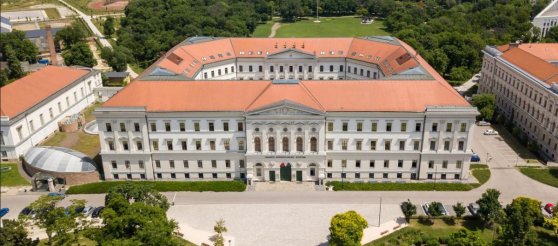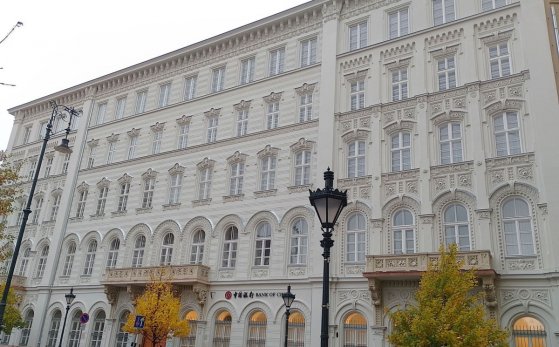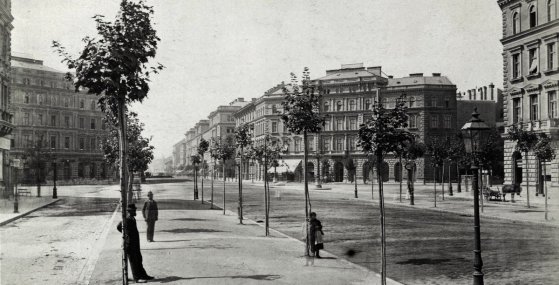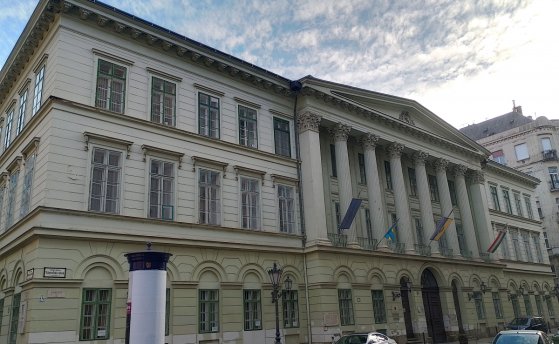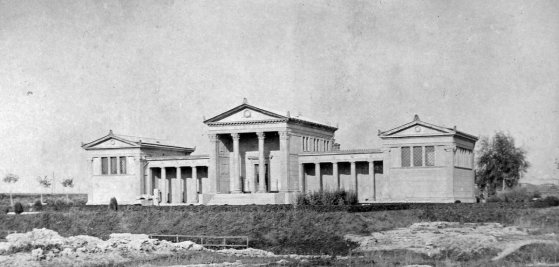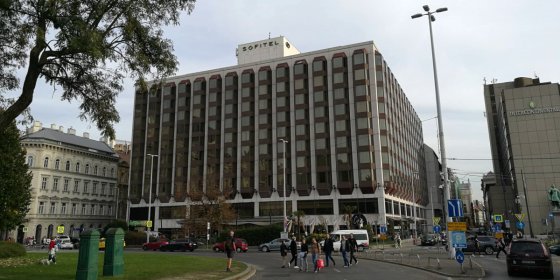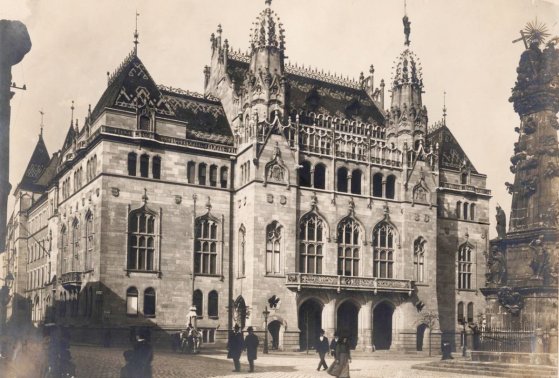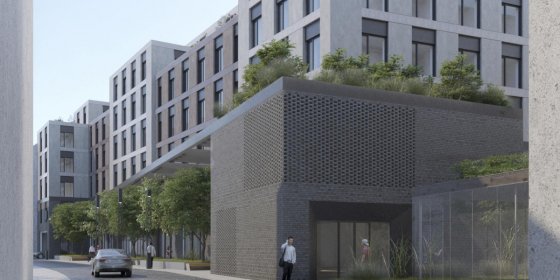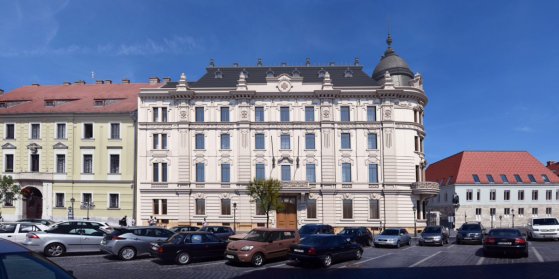 The „intertwined history” of the bridges and the city of Budapest
Which ideas and events have shaped the fate of bridges of Budapest and the cityscape? Alongside many other interesting facts, this question is also answered this newly published book by the Budapest City Archives, which introduces the history of bridges in Budapest.
The „intertwined history” of the bridges and the city of Budapest
Which ideas and events have shaped the fate of bridges of Budapest and the cityscape? Alongside many other interesting facts, this question is also answered this newly published book by the Budapest City Archives, which introduces the history of bridges in Budapest.
Architecture
 The capital launched a housing construction program during a crisis in the 1920s
The capital launched a housing construction program during a crisis in the 1920s
December 7, 2022 at 11:00 AM
During the period of dualism in Budapest, most residential buildings were built by private investors, as there was a huge demand for them at that time: large crowds moved to the capital. The trend continued even after World War I, but at that time the economic environment was not nearly as favourable, so the capital itself launched a small flat construction program. Several buildings were completed by November-December 1926, the first residents moved in ninety-six years ago.
The Ludovica Academy: 150 years of Hungarian officer training
December 4, 2022 at 11:00 AM
One hundred and fifty years ago, in 1872, the Ludovica Academy, the military school for the training of officer cadets, was opened. The 1808 Diet decided to start Hungarian officer training, but the education actually started only 64 years later. The academy's own building in the 8th District was already built between 1830 and 1836 from public donations, according to the plans of Mihály Pollack, but the classicist palace was unused for decades. However, a law of 1872 once again ordered the establishment of the Hungarian Royal Hungarian Defense Academy.
A 110-year-old school building in Ferencváros - one of Albert Kálmán Kőrössy's masterpieces
December 1, 2022 at 9:00 AM
One of the large-scale masterpieces of Art Nouveau school architecture is bounded by three streets, Lenhossék, Vendel and Balázs Béla. Its main facade is so huge that people have to walk at least 50 metres away from it to admire its beauty. When it was completed, it stood out among the single-story houses in central Ferencváros. Nowadays, it is mostly surrounded by modern residential buildings, and perhaps there would be a residential building in its place too if it had not been given a new function a few years ago.
Master of Romanticism Hugó Máltás passed away 100 years ago
November 27, 2022 at 10:00 AM
Hugó Máltás is one of our lesser-known architects, even though he had an extremely long career and life: he died at the age of ninety-four, in 1922. The fact that his name did not enter the public consciousness can be attributed to his much more busy contemporaries, primarily Miklós Ybl. However, Máltás also designed quite a lot, especially during the period of Romanticism. A summary of his works is presented below.
Lajos Lechner, the creator of modern Budapest, died 125 years ago
November 18, 2022 at 9:00 AM
Lechner is a well-known name in the world of architecture and engineering: the former is mainly due to Ödön Lechner, and the latter to Lajos Lechner. Despite the same family name, they were not related, and their artistic and technical talent developed independently of each other. Lajos, who died 125 years ago, moved on a completely different path than Ödön, who was a good decade younger than him. Take a look at a summary of what Hungary and especially Budapest, owes to him.
Whose masterpieces were demolished: Mátyás Zitterbarth Jr. died 155 years ago
November 14, 2022 at 9:00 AM
The development of a large city is always accompanied by the demolition of buildings, as old ones are replaced by new ones that already meet modern needs. Mátyás Zitterbarth Jr., who created in the first half of the 19th century, largely fell victim to this phenomenon. However, he was a brilliant architect, which is proven by the fact that the mayors of the city of Pest entrusted him with the design of important public buildings. Pestbuda now presents his demolished and still-standing works.
Nuns and communists also used the present headquarters of the Institute for the Blind
November 11, 2022 at 10:00 AM
Hermina Road, which marks the eastern border of City Park, is primarily known for its churches: the Hermine Chapel, which also gives its name, and the Church of the Immaculate Conception on the corner of Ajtósi Dürer Way. However, between the two hides a lower, yet dignified-looking building, which was originally built by the Franciscan Missionaries of Mary and handed over ninety-five years ago.
The rabbinical seminary opened its doors in Budapest 145 years ago
November 8, 2022 at 4:00 PM
In Budapest, at the corner of Bérkocsis and Bodzafa Streets in the Józsefváros district - at the intersection of today's Gutenberg Square, Scheiber Sándor and Somogyi Béla Streets - in October 1877, a solemn event took place that was rare even in the world of the time. The rabbinical seminary, in which Israelite students began their studies, opened its doors to the Hungarian Jewish people.
Bauxite concrete panic in Budapest - All affected houses were inspected 55 years ago
November 3, 2022 at 11:00 AM
In the 1960s, experts assumed with horror that a time bomb was ticking in the buildings of Budapest. A hotel ceiling crashed in, an apartment building began to crack incredibly fast right in front of an architecture professor. Bauxite concrete was responsible, so they searched and examined all the affected buildings in the capital. All this happened 55 years ago.
Art Nouveau on tombstones - An attempt to renew cemetery art
November 2, 2022 at 10:00 AM
Around the Day of the Dead, many of us visit the graves of our loved ones, and at this time we can discover that the cemetery is also a repository of real works of art. At the beginning of the 20th century, Art Nouveau, which broke with classical forms, permeated this area as well, and artists tried to offer new solutions to those who ordered tombstones. One of the most enthusiastic of them was the sculptor Richárd Füredi, who together with two of his colleagues organised an exhibition to introduce his works reflecting the new taste to the general public.
Light permeates the reborn Ráday House
October 28, 2022 at 9:00 AM
Large-scale construction had been going on in Ráday Street, and especially Markusovszky Square, in recent years, the veil has recently been lifted: the new building of the Ráday Dormitory, which burned down in early 2019, has been completed. The works also included the renovation of the original centre, so an entire block of buildings was reborn in the heart of Ferencváros. Old and new blend together harmoniously, perfectly expressing the Christian values prevailing between the walls.
The domes of the Adria Palace are already in place
October 25, 2022 at 2:00 PM
The restored domes of the former headquarters of Adria Royal Hungarian Sea Navigation Company on Szabadság Square can already be seen. The facade and roof ornaments of the palace, designed by Arthur Meinig are being renovated based on archival photos.
From the Curia's building to the City Park: the Hungarian National Gallery opened 65 years ago
October 25, 2022 at 10:00 AM
The Hungarian National Gallery is one of the best-known institutions in the country and the capital, which celebrates its 65th anniversary this year. The institution, which collects masterpieces of Hungarian art, opened its doors to visitors on 5 October 1957 in its first home, in the Curia's building on Kossuth Square designed by Alajos Hauszmann, to which the Museum of Ethnography later moved. It occupied its current location, buildings B, C and D of the Buda Castle, in 1975. Within the framework of the Liget Project, the plans for the new home have already been drawn up, although its implementation is still pending.
The Party Office on the former Köztársaság Square does not allow the past to be sealed off
October 22, 2022 at 9:00 AM
Although the party office with a dark past has been continuously deteriorating for years in the former Köztársaság, today's II. János Pál pápa Square, it has not yet been possible to demolish or rebuild it. Moreover, its immediate surroundings were recently declared life-threatening and closed, so instead of being converted into a residential building as planned, the socialist realism style building continues to remind us of the bloody events of the 20th century and the 1956 revolution.
Budapest acquired two hated buildings 125 years ago
October 21, 2022 at 10:00 AM
Several well-known symbols of oppression of Hungary and Budapest stood in the centre of the capital even in the decades after the Austro-Hungarian Compromise. One is the Citadella fortress built to intimidate the city after the defeat of the War of Independence on top of Gellért Hill, and the other is the huge New Building, also known as the prison of soldiers of the 1848 national army, with a bad memory, on the site of today's Szabadság Square. Budapest acquired these two military facilities in October 1897. The New Building was demolished in a short time, but they could not do anything with the Citadella for decades.
They collected memories of old times - Budapest founded a museum 135 years ago
October 20, 2022 at 3:00 PM
Budapest's position as the capital provides many advantages but sometimes it also comes with disadvantages. This was also the case in the area of museums: because the Hungarian National Museum was established here in 1807, the capital was able to establish its own institution only eighty years later - after many rural settlements. However, on 20 October 1887 - exactly 135 years ago - the decision was finally made and the Capital Museum was established.
The church and monastery were turned into a place of entertainment - the Castle Theatre opened 235 years ago
October 16, 2022 at 9:00 AM
One of the characteristic buildings of the Buda Castle is the Carmelite monastery, which has been used by the Prime Minister's Office for almost four years. The eponymous order of monks was actually forced to withdraw from the walls a long time ago, precisely 235 years ago, their church was turned into Castle Theatre. The ruthless intervention also greatly affected the building itself, but it was mostly then that the image that is known today was formed.
The hotel on the site of the former Lloyd Palace is being rebuilt
October 12, 2022 at 9:00 AM
Due to the ravages of World War II, Pest's Danube Promenade lost its former unique atmosphere. Modern hotels have been built in place of the old row of palaces, and the Atrium Hyatt has stood on the site of the destroyed Lloyd Palace since 1982, which today bears the name Sofitel. The hotel will soon receive a new facade, the building permit became final at the beginning of October. It can be read in the permit that the building will get a new level. Design renders have not yet been released.
A romantic jewellery box in Zugló - The construction of the Hermine Chapel began 180 years ago
October 10, 2022 at 5:00 PM
One of the typical buildings on Hermina Road, which marks the eastern border of City Park, is the small Hermina Chapel. Despite its size, it has a very decisive role, as not only the road was named after it, but also the district where it stands: Herminamező. In keeping with its style, its story is also romantic, containing both beauty and tragedy. The foundation stone of the small chapel was laid just one hundred and eighty years ago.
The Palace of the Ministry of Finance was completed 115 years ago
October 7, 2022 at 9:00 AM
It is lesser known that on 7 October 1907, the construction works of the Ministry of Finance's Szentháromság Square palace were completed. The significant construction work took place between October 1901 and December 1904, but the post-construction work continued until October 1907. And several pivotal dates are connected to the construction itself.
Imre Madách Secondary School moved into its current home 130 years ago
October 5, 2022 at 11:00 AM
In September 1892, the 7th District State Secondary School, i.e., today's Imre Madách Secondary School, welcomed not only the new academic year but also its new home. The institution, founded in 1881, did not have its own building for more than 10 years, teaching took place on rented premises. The Minister of Religion and Public Education in charge of educational affairs, Ágoston Trefort, commissioned the architect János Bobula Sr. to prepare the plans for the secondary school. But Trefort passed away in the meantime, and the new minister had other ideas about the school building.
110-year-old neighbours - The twins of the big school building campaign
October 3, 2022 at 2:00 PM
Fortunately, there are many architecturally valuable school buildings in Budapest. A significant part of them was created in a very short period, in just three years: the Capital implemented a large school building program between 1909 and 1912. Many well-known alma maters were born at this time, but Pestbuda now presents two less famous examples of this fertile era.
It was once a steam bath, now a hotel is being built on Kazinczy Street
September 30, 2022 at 10:00 AM
At 40-48 Kazinczy Street in the 7th District, the area on which a 270-room hotel with a two-story underground garage can now be built was created by combining five lots. As part of the works, a section of the street will also be renovated, and the buildings currently standing on the lots will be demolished, so it is expected that the former steel-and-glass block of the Hungarian Dance Academy and the historicising house at 48, known first as a meat factory and then as a nightclub, will also be torn down.
Even the economic crisis could not stop construction – The first Neo-Renaissance houses on Andrássy Avenue
September 29, 2022 at 11:00 AM
Similar to the last few crisis-filled years, there were also economic difficulties in the past centuries, which also had an impact on the construction industry. Such was the crisis of 1873, which very sensitively affected the mega-investment of the era, the constructions along Andrássy Avenue. Fortunately, construction began here as early as 1872 - i.e., 150 years ago - and some residential houses were soon completed, setting a good example for further construction.
The former headquarters of the Red Cross Society will soon show its original appearance
September 24, 2022 at 9:00 AM
The reconstruction of the building in Buda, originally designed by Alajos Hauszmann and Dezső Hültl, began in 2021, and recently the structural construction work was completed, so in addition to the construction of the roof and facade, the interior work will start in the autumn. With the reconstruction of the house at 1-2 Dísz Square, a wound in the cityscape that has been open for more than seventy years will be healed.
Postponed constructions in the capital
September 20, 2022 at 4:00 PM
The government decided to postpone and reschedule a total of 284 planned state investments, according to a list published a few days ago. The measure also affects construction projects in Budapest: the conversion of the Kelenföld railway station building or the development of the ELTE Trefort Garden campus will be postponed, among other things.
The new building of the Luther Home in the 11th District was inaugurated
September 19, 2022 at 6:30 PM
The new building of the Luther Home - Evangelical Student Home opened its doors in the 11th District, on the site of the headquarters of the Ecumenical Council of Churches in Hungary. The modern, 21st-century higher education college was built in Lágymányos, next to the universities.
Imre Steindl, who died 120 years ago, could not see the handover of the Parliament
September 19, 2022 at 12:30 PM
Imre Steindl's name has merged with his main work, the Budapest Parliament. Thanks to one of the largest parliament buildings in the world, the master is included in the universal history of art, which can only be said of a few Hungarian architects. However, he had to work a lot to get to this point, fortunately, the main stages of his work can still be seen today, and they largely adorn the capital. Below, Pestbuda presents his lesser-known buildings in Budapest, thus remembering the architect on the 120th anniversary of his death.
The Pest homes of Zsigmond Móricz, who died 80 years ago
September 15, 2022 at 9:00 AM
Not only Dezső Kosztolányi (Üllői úti fák [Trees of The Üllői Road]) but also Zsigmond Móricz could come to our mind when we think of Üllői Road. One of the most famous authors of 20th-century Hungarian realist prose literature lived for twenty years in his home on Üllői Road, where such defining works as Tragédia [Tragedy] and Légy jó mindhalálig [Be Faithful Unto Death] were written. After the suicide of his first wife, the writer moved to an apartment building on Fővám Square with his daughters and then lived for a short time in an apartment in a pre-modern style house on Bartók Béla Road. Zsigmond Móricz, whose name is preserved by public works, public institutions, literary scholarships and numerous public spaces, died eighty years ago.
The first gems of the Hegyvidék - József Hild's villas in Buda
September 11, 2022 at 10:30 AM
More and more people moved from Pest, which began to grow in the first half of the 19th century, to the mountains of Buda, because instead of traffic and crowding, calmness and fresh air awaited them there. The larger plots also made it possible to build free-standing villas with gardens, many of which were designed by the most employed architect of the period, József Hild.
More articles
 The „intertwined history” of the bridges and the city of Budapest
Which ideas and events have shaped the fate of bridges of Budapest and the cityscape? Alongside many other interesting facts, this question is also answered this newly published book by the Budapest City Archives, which introduces the history of bridges in Budapest.
The „intertwined history” of the bridges and the city of Budapest
Which ideas and events have shaped the fate of bridges of Budapest and the cityscape? Alongside many other interesting facts, this question is also answered this newly published book by the Budapest City Archives, which introduces the history of bridges in Budapest.
 The Bridge Report, which brought a turning point in the history of Budapest
A travel report that changed the history of Pest and Buda, as well as Hungary. The little book contributed to the change of half a thousand years of legal customs and the implementation of an investment of unprecedented size and technical quality. This book was The Bridge Report [Hídjelentés in Hungarian].
The Bridge Report, which brought a turning point in the history of Budapest
A travel report that changed the history of Pest and Buda, as well as Hungary. The little book contributed to the change of half a thousand years of legal customs and the implementation of an investment of unprecedented size and technical quality. This book was The Bridge Report [Hídjelentés in Hungarian].
 Drama on the university wall - The heroic monument was planned 95 years ago
In the constant hustle and bustle of the Egyetem Square in Pest, the students may not even notice the monument that decorates the short section of wall between the church and the central building of ELTE. However, it commemorates their predecessors, the heroes who fought for their country in World War I, and those who heroically helped them. The first design of the dramatically collapsing soldier was born in 1928, ninety-five years ago.
Drama on the university wall - The heroic monument was planned 95 years ago
In the constant hustle and bustle of the Egyetem Square in Pest, the students may not even notice the monument that decorates the short section of wall between the church and the central building of ELTE. However, it commemorates their predecessors, the heroes who fought for their country in World War I, and those who heroically helped them. The first design of the dramatically collapsing soldier was born in 1928, ninety-five years ago.

